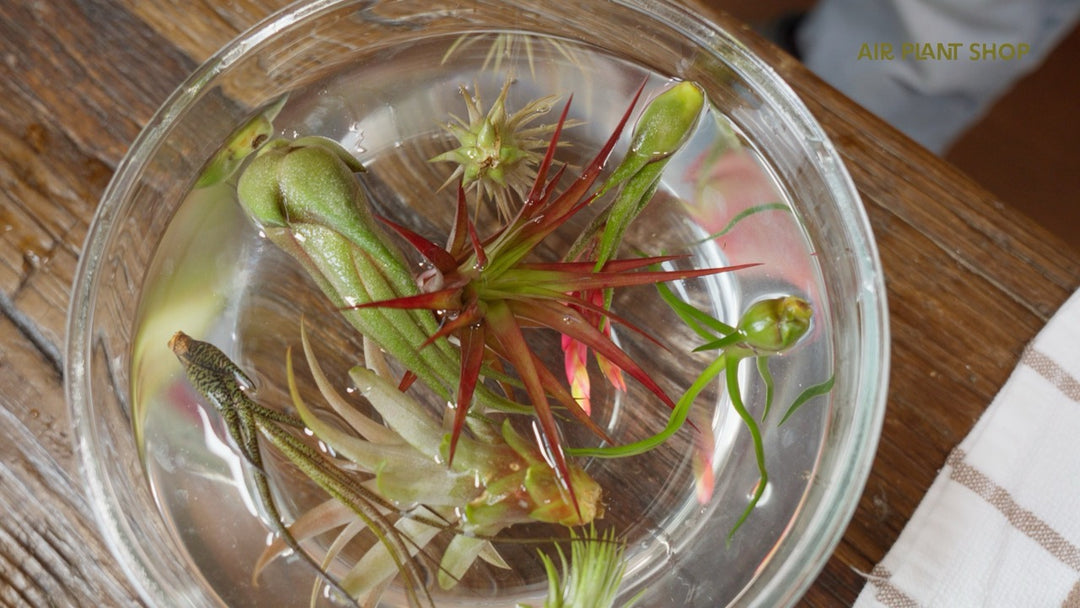
How Do Air Plants Multiply? A-Sexual vs. Sexual Reproduction
One of the many reasons people cherish Tillandsias is the fact that with patience and love, you can be rewarded with a family of smaller air plants after the original plant has bloomed. This type of a-sexual reproduction by off-sets or “pups” is the most reliable way to propagate air plants, especially in a home or residential garden environment. However, it is not the only way we produce air plants that we sell for your enjoyment! At our farm, we also practice seedling reproduction. Reproducing the various species through seeds and pollination is a more arduous process, requiring years of patience, nevertheless we are rewarded with a high quantity of quality plants in the long term.
Both types of reproduction begin once the air plant has reached maturity. An air plant is considered to be mature when it has begun to bloom. After blooming, a plant is ready to start both processes below, sometimes concurrently.
“By Pups” aka A-Sexual Reproduction
The idea of a plant multiplying by “pups” is not a new concept to gardeners and plant hobbyists. Various tuberous lilies, heliconias, hostas, banana plants and of course ground bromeliads (the closest cousin to Tillandsias) are known for creating smaller plants at the base of the mature plants. These new plants are able to be divided and moved to different parts of the garden or shared with friends. Of course you can always choose to leave the plant alone and it will either grow in size or spread out to cover more ground. For air plants, these same ideas hold true.

During or shortly after blooming for their first and final time, an air plant will start to produce at least a couple of pups from its base. After blooming (and possibly producing seeds–outlined later), the original plant, lovingly called “mothers” at the farm, will cease in the production of fresh leaves from its center and will dedicate the rest of its energy to pups. At the nursery, these pups are split from the mother plant by hand once they reach about ⅓ her size – learn how to divide air plant babies from mother plants from our blog "How to Divide Air Plant Pups". If pups are removed too early, they struggle to grow on their own. If they are taken too late, it can limit the total quantity of pups that the mother plant will produce.

Original plants will continue producing pups despite looking ragged with broken or decaying leaves. The image on the right exemplifies this perfectly as the Tillandsia Pruinosa mother plant deteriorates and gives all of her energy to the pups to ensure the life cycle continues. Pups are always genetically identical to the original plant. Characteristics such as foliage, texture or bloom colors will be maintained in subsequent generations of pups. This is important to consider when a unique air plant hybrid is created either naturally or by an enthusiast–the only way to ensure consistency would be by reproducing the plant with pups. Tissue culture (considered a human-assisted a-sexual reproduction) of tillandsias has not yet proven successful at a commercial scale.
If plants are not divided, they produce clumps, which for some, is more exciting and beautiful than having many individual plants. In nature, clumps will start to grow around and eventually circumnavigate entire tree branches. In a nursery or home setting, an air plant clump can grow to form beautiful symmetry if it is hung by a wire, allowing it to hang freely. If you are interested in clumping air plants, check out our Tillandsia Tenuifolia Clumps and Tillandsia Funckiana Clumps.
“By Seedlings” aka Sexual Reproduction

Also after blooming, air plants will attempt to reproduce by creating seeds (as seen in image on the right). The viability of seeds is highly dependent on the proximity of other mature (blooming) tillandsia and the prevalence of active pollinators in the area. If pollination is successful, seed capsules begin forming between the dried bracts of an old bloom months after the bright colors have faded away. In fact, we collect most of the seeds about a year after the plant has bloomed. However, not all bloomed-out plants will go on to produce seeds. And while some will seemingly produce the cotton-like material that should contain the small seeds, sometimes the seeds do not form. However, these inconsistencies with seed production are outweighed by the sheer number of seedlings that you can obtain in the right conditions.

At our farm, the seeds and capsules are collected by species and stored in small tubs until a large amount is acquired. Then, the cotton-like seed mixture is spread on mesh screens. The material is watered-in and monitored daily for months so that proper humidity and light is maintained. It is also very important to label our mesh panels with the species name, since after germination, all tillandsia are pretty much indistinguishable from each other for several years. It takes four to six months before tiny, green germinated air plants are visible. A successful seedling panel (normally about one square meter) can contain 3,000 or more seedlings. As the plants begin to mature, constant dividing and moving of the juvenile tillandsias is required for them to maintain symmetry and air flow. A plant started from seedling may be moved 20 or more times before it is ready to sell. As you can imagine, this laborious and meticulous job is only for the most skilled and experienced individuals.
Learn more about our sustainable nursery practices in our "Environmentally Conscious Farming" blog.

Not all seedlings go on to be sold into the trade – seedling plants also end up making good mother plants for a-sexual reproduction. Seedling plants have good genetic diversity and strength compared to regular pups. Seedling plants may not always be true to name, and occasionally gorgeous hybrids will be the result at the farm! One might assume that a great deal of the air plant seedlings would go on to be hybrids due the density of species at the farm, but the reality is most of our seedlings remain true to the original species. We believe this is due to different blooming seasons, which help prevent cross pollination, and the tendency of certain pollinators to only pass by certain species of air plants. For example, Tillandsia Caput Medusae have a rather specific blooming period at the end of our nursery’s dry season (February-April) and we find they are primarily pollinated by hummingbirds. Other air plants blooming at this time are not as commonly visited by hummingbirds, thus preventing hybridization.
Plants grown from seed are coveted by enthusiasts because they frequently show a full adult form at a much smaller size – a great example of this is our Tillandsia Xerographica Seedling which, as the name implies, is grown from seed and actually required to be grown from seed as it is a protected species. They also have a tendency to have more leaves at one time since smaller leaves are maintained as the base of the plant. The seedling process from bloom, to see capsule, to “cotton”, to germination brings tangibility to tillandsias natural spreading process. Once you understand the steps, it is easy to see how a tillandsia’s seed gets carried in the wind to be tangled in the bark of a tropical hardwood tree, germinate, grow, bloom and produce a beautiful clump.
Want to learn more about air plants? Check out our "What are Tillandsia?" blog post or dive deeper into the the regions of where air plants are from with our "Mesic, Xeric and Hydric Air Plants" blog.
Or want to see some air plants in the wild? Check out our "Tillandsia Safari Quiché, Guatemala" blog and "Tillandsia Safari Petén, Guatemala" blog.








Love your air plants.
Leave a comment